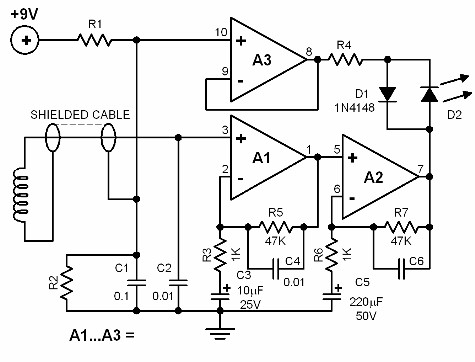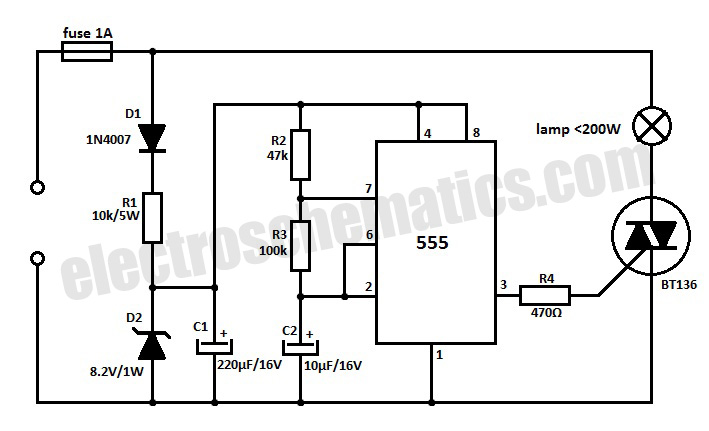
220V live wire-in-wall scanner

This little circuit will help you to scan the line of a 220V live wire in the wall. The FET gate is connected to a capacitive metal sensor (which is usually a simple metal plate). When you hold the sensor close to the wall, the LED will indicate the current flow around where it detects the wire. Works on 9VDC.
The described circuit functions as a non-contact voltage detector, utilizing a capacitive sensing mechanism to identify the presence of an AC voltage source, specifically a 220V live wire. The core components of the circuit include a Field Effect Transistor (FET), a capacitive metal sensor, an LED indicator, and a power supply of 9V DC.
The capacitive metal sensor acts as the sensing element, detecting changes in the electric field caused by the presence of the live wire. When the sensor is brought near the wall, the electric field around the 220V wire influences the gate of the FET. The FET is configured in such a way that it turns on in response to the capacitive coupling from the sensor, allowing current to flow through the LED.
The LED serves as a visual indicator, illuminating when the FET is activated by the detected electric field, thus signaling the presence of the live wire. The circuit is powered by a 9V DC supply, which is necessary to ensure that the FET operates within its optimal range.
In terms of circuit design, appropriate resistors may be included to limit the current through the LED and to set the gate threshold of the FET. Additionally, a capacitor could be placed in parallel with the FET to filter out any noise and enhance the stability of the detection signal.
This circuit is particularly useful for electricians and DIY enthusiasts who need a safe method to locate live wires behind walls without direct contact. It is important to note that while this circuit can indicate the presence of voltage, it does not provide information about the current or the specific characteristics of the electrical system. Proper safety precautions should always be observed when working around live electrical circuits.This little circuit will help you to scan the line of a 220V live wire in the wall. The FET gate is connected to a capacitive metal sensor (which is usually a simple metal plate). When you hold the sensor close to the wall, the LED will indicate the current flow around where it detects the wire. Works on 9VDC. 🔗 External reference
The described circuit functions as a non-contact voltage detector, utilizing a capacitive sensing mechanism to identify the presence of an AC voltage source, specifically a 220V live wire. The core components of the circuit include a Field Effect Transistor (FET), a capacitive metal sensor, an LED indicator, and a power supply of 9V DC.
The capacitive metal sensor acts as the sensing element, detecting changes in the electric field caused by the presence of the live wire. When the sensor is brought near the wall, the electric field around the 220V wire influences the gate of the FET. The FET is configured in such a way that it turns on in response to the capacitive coupling from the sensor, allowing current to flow through the LED.
The LED serves as a visual indicator, illuminating when the FET is activated by the detected electric field, thus signaling the presence of the live wire. The circuit is powered by a 9V DC supply, which is necessary to ensure that the FET operates within its optimal range.
In terms of circuit design, appropriate resistors may be included to limit the current through the LED and to set the gate threshold of the FET. Additionally, a capacitor could be placed in parallel with the FET to filter out any noise and enhance the stability of the detection signal.
This circuit is particularly useful for electricians and DIY enthusiasts who need a safe method to locate live wires behind walls without direct contact. It is important to note that while this circuit can indicate the presence of voltage, it does not provide information about the current or the specific characteristics of the electrical system. Proper safety precautions should always be observed when working around live electrical circuits.This little circuit will help you to scan the line of a 220V live wire in the wall. The FET gate is connected to a capacitive metal sensor (which is usually a simple metal plate). When you hold the sensor close to the wall, the LED will indicate the current flow around where it detects the wire. Works on 9VDC. 🔗 External reference





